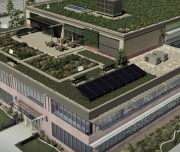Relevant Mandates and Rating Systems
| Mandates / Standards | Rating Systems |
|---|
Guiding Principles for Sustainable Federal Buildings
- “Employ strategies that reduce stormwater runoff and discharges of polluted water offsite, to protect the natural hydrology and watershed health"
- The principles encourage the use of life-cycle cost-effective renewable electric energy projects, potentially including the installation of rooftop solar panels.
Guiding Principles for Sustainable Federal Buildings
P100 Facilities Standards
The GSA P100 Facilities standards establishes various requirements for several tiers of high performance federal buildings, with more stringent requirements getting awarded higher . The requirements for tier improvements include requirements for waterproofing, roof replacement, vegetative systems, roof drainage systems, roof service life, among others. Learn more at GSA's P100 page.
Presidential Memorandum - Creating a Federal Strategy to Promote the Health of Honey Bees and Other Pollinators
The President issued a memorandum directing U.S. government agencies to take additional steps to protect and restore domestic populations of pollinators, including honey bees, native bees, birds, bats, and butterflies. Planted roofs with flowering plants can provide habitats and food supplies for pollinators. Learn more at the White House Press Office.
Energy Independence and Security Act (2007)
The Energy Independence and Security Act (EISA) requires projects involving any Federal facilities with a footprint that exceeds 5,000 square feet to maintain or restore, to the maximum extent technically feasible, the predevelopment hydrology of the property with regard to the temperature, rate, volume, and duration of flow (EISA Section 438). Stormwater management provided by a planted roof can help federal agencies meet this requirement. For more information, see EISA 2007 at GPO.gov and EPA's Technical Guidance for meeting EISA Section 438 stormwater runoff requirements.
Environmental Policy Act of 2005 (EPAct 2005)
The Environmental Policy Act of 2005 offers tax incentives for many energy and sustainability improvements that planted roofs can provide. A tax incentive of up to $1.80 per square foot of buildings that demonstrate certain energy efficiency requirements can be given. More information is available from the Department of Energy.
Other Guidelines
Many institutions outside of the federal government are creating guidelines and standards for planted roofs. ASTM International has developed standard guidance for planted roofs (E2777-14), as well as standards for vegetation (E2400-06) and the calculation of the dead (E2399-11) and live loads of a planted roof (E2397-11). The American National Standards Institute has issued standards regarding how to take wind into account when building a planted roof (RP-14) and how to prevent fires (VF-1).

